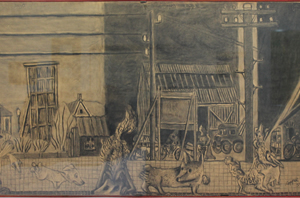Exile and Immigration
Revolutions, political radicalism, war or the prospect of a better life. The reasons for continental Europeans to desert their homes and countries are numerous and filled with many twists and unexpected turns. The people of Wales opened their doors to thousands of refugees not only during the French Revolution, the European revolutions of 1848 and the two World Wars, but they continue to welcome visitors from diverse backgrounds to this day.
During the French Revolution, a number of aristocrats travelled to Wales to escape the daily routine of their exile in London. In 1806, one of these, Antoine Philippe d'Orléans, cousin of the executed king of France, explored the Welsh countryside to improve his artistic skills. But for many other refugees in Britain during the nineteenth century, the circumstances of their exile were exactly the reverse, because their attempts to establish freely elected governments had failed. During the March Revolution of 1848, Johann Heinrich Bettziech, a journalist from Saxony, had distributed a number of anti-monarchist leaflets and so incurred the personal wrath of the Prussian king, Friedrich Wilhelm IV. During his British exile, Bettziech explored a number of coalmines and ironworks in south Wales and wrote sympathetic accounts for his German readers of the dangerous and badly paid work undertaken by the Welsh workers.
The two World Wars brought death and devastation to the whole of Europe. The lives of the Welsh population were affected not only by the rationing of goods, bombing raids and the loss of soldiers at the front, but also by the increased presence of continental Europeans in Wales. Many people escaped to Wales as refugees, some were sent to Wales in an effort to rescue them from persecution, such as the Basque children escaping the Spanish Civil War in 1937, and others were detained as prisoners of war. Whilst most of the refugees and imprisoned soldiers headed homewards after the wars had ended, the majority of the Jewish children from Germany who had been brought to Wales in the Kindertransport of 1939, such as Ellen Davies who was sent to Swansea, had lost the families or homes to which they could have returned.
However, political upheaval or wars were not the only reasons for continental Europeans to come to Wales. The large Spanish and Eastern European communities of south Wales are testament to the large waves of continental immigration during the industrial age. For about a hundred years until the second half of the twentieth century, the Sioni Winwns, the onion sellers from Brittany, had been a familiar sight around the Welsh streets. And to this day, Italian immigration has left its mark on many a seaside town where the local chip shops and ice cream parlours are run by Italian families, who sell their goods to holidaymakers and other European travellers.




